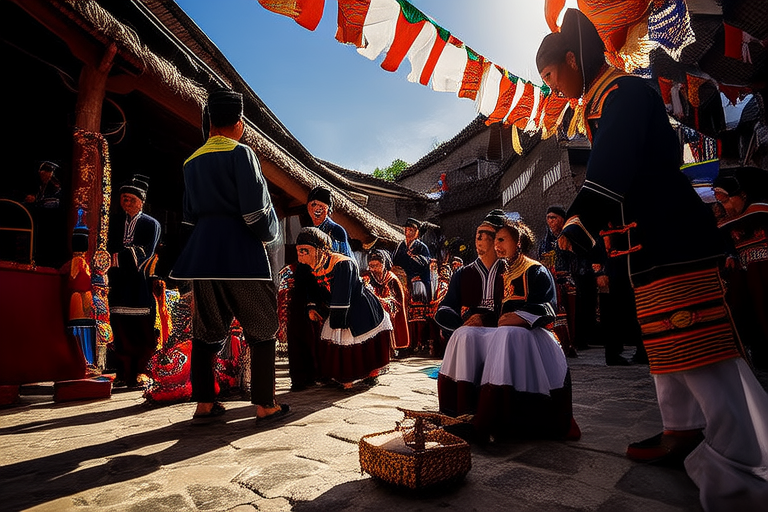Illuminating Cultural Customs: How Local Traditions Shape Identities

Illuminating Cultural Customs: How Local Traditions Shape Identities
Introduction
Cultural identity is the unique blend of values, beliefs, and practices that define a community or an individual. It encompasses the shared history, language, and customs that create a sense of belonging and distinction. Understanding the local traditions of a place is not just a matter of curiosity; it is essential for travelers seeking to truly connect with the people and places they visit. These traditions are the threads that weave together the fabric of a culture, contributing to its unique character and allure. Whether through music, dance, cuisine, or rituals, local customs offer profound insights into the lives and values of those who practice them.
For travelers, immersing themselves in these traditions can transform a trip from a mere sightseeing adventure into a meaningful exploration of another way of life. It fosters mutual respect and appreciation, bridging gaps between diverse cultures and promoting a deeper understanding of the world. This article delves into how local traditions and cultural customs play a significant role in shaping both individual and collective identities across different regions of the world.
The Role of Traditions in Identity Formation
Local customs, rituals, and practices are integral to the formation of personal and communal identities. They serve as the foundation upon which individuals build their self-concept and find their place within society. In many indigenous communities, for example, participation in traditional ceremonies and storytelling plays a pivotal role in transmitting cultural knowledge and reinforcing group cohesion. The Maasai people of East Africa engage in elaborate rites of passage that mark the transition from childhood to adulthood. These ceremonies are not only celebrations but also educational experiences where young Maasai learn about their ancestry, responsibilities, and societal roles.
In Japan, the tea ceremony exemplifies how ritualized practices can deepen one’s connection to cultural heritage. Participants in the tea ceremony follow strict protocols that emphasize mindfulness, respect, and harmony. Through this practice, individuals gain a heightened awareness of their place within the broader cultural context. Similarly, the Day of the Dead (Día de los Muertos) in Mexico celebrates the lives of deceased loved ones. Families construct altars adorned with photos, favorite foods, and personal mementos. This tradition not only honors the dead but also strengthens familial bonds and reinforces a shared cultural identity among participants.
Impact on Daily Life
Local traditions permeate every aspect of daily life, influencing everything from food and clothing to festivals and social interactions. Cuisine, in particular, serves as a powerful expression of cultural identity. In Italy, pasta dishes vary significantly by region, reflecting local ingredients and cooking techniques. For instance, the Ligurian region is known for its pesto, made from basil, pine nuts, garlic, and olive oil, while Sicily offers a rich array of seafood-based specialties. Each dish tells a story about the land, the people, and their historical influences.
Fashion, too, often carries deep cultural significance. Traditional attire can be a form of cultural expression, marking important occasions and signifying social status. In India, sarees are worn during weddings and other festive events, symbolizing beauty, grace, and cultural pride. In Scotland, kilts have become emblematic of Scottish identity, worn both at formal gatherings and casual events. The intricate patterns and colors of each kilt tell the wearer’s clan affiliation and regional origin.
Festivals and celebrations are perhaps the most visible manifestations of cultural traditions. Mardi Gras in New Orleans, USA, combines elements of French, African, and Native American cultures, creating a vibrant spectacle of parades, costumes, and music. In Brazil, Carnival is a week-long celebration featuring samba dancing, elaborate floats, and street parties. These events bring communities together, fostering a sense of unity and shared purpose. Social interactions are also shaped by cultural norms. In many Middle Eastern countries, hospitality is a cherished virtue, with guests often treated like royalty. Visitors are frequently invited into homes, offered refreshments, and engaged in lively conversations, reinforcing the value placed on relationships and community.
Preservation and Evolution
While local traditions are deeply rooted in history, they are not static. Modernization and globalization pose both challenges and opportunities for preserving these customs. On one hand, rapid urbanization and technological advancements can erode traditional practices, leading to a loss of cultural heritage. On the other hand, these same forces can provide new platforms for sharing and revitalizing cultural traditions.
Efforts to preserve cultural customs often involve documentation, education, and community engagement. In Bali, Indonesia, traditional dances are being taught to younger generations to ensure their continuation. Museums and cultural centers worldwide work to safeguard artifacts and oral histories, making them accessible to future generations. Additionally, social media and digital platforms allow for the dissemination of cultural practices to a global audience, helping to keep traditions alive.
At the same time, traditions evolve to meet the changing needs of society. For example, in many parts of Asia, traditional medicine practices have been integrated into modern healthcare systems. Herbal remedies and acupuncture continue to be used alongside Western medical treatments, offering patients holistic approaches to wellness. Similarly, traditional crafts are being adapted for contemporary uses, such as fashion design or home decor, ensuring their relevance in today’s market.
Conclusion
Local traditions and cultural customs play a vital role in shaping identities, both individually and collectively. From the rituals of coming-of-age ceremonies to the daily practices of preparing meals, these traditions infuse everyday life with meaning and purpose. They reflect the values, beliefs, and aspirations of a community, creating a sense of continuity and belonging.
As we navigate an increasingly interconnected world, it is more important than ever to respect and appreciate these traditions. By doing so, travelers can enrich their own experiences and contribute to the preservation of cultural heritage. When we embrace the diversity of cultural expressions, we foster a greater understanding and appreciation of our shared humanity. Let us celebrate the richness of local traditions and recognize their enduring impact on the identities that shape our world.